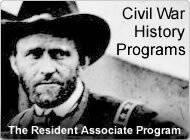
Book Review - Surviving the Confederacy: Rebellion, Ruin, and Recovery - Roger and Sara Pryor During the Civil War, by John C. Waugh, Reviewed by Antigoni Ladd
The Smithsonian Associates Civil War E-Mail Newsletter, Volume 6, Number 3
What would it be like to live in the midst of war: To have your house in the path of a moving army -- two moving armies? How do you live day-to-day, trying to protect, feed and clothe your children? Or, trying to earn a living while not knowing when the horrors will end, or if they ever will? Fictional accounts like Gone with the Wind certainly do not give us a true picture of common life during the Civil War, so we keep searching historic accounts, both fiction and non-fiction, hoping to catch a glimpse of life at the home front.
John C. Waugh, former bureau chief for the Christian Science Monitor, has given us just such a story. This is the true story of Roger and Sara Pryor of Virginia. Roger, an editor, lawyer, member of Congress, and a soldier during the war, was married to the accomplished Sara. They lived in Richmond, Washington, DC, and Petersburg before and during the war. Being members of the southern aristocracy, the Pryors had access to the key leaders of the Civil War era, from Stephen A. Douglas to Robert E. Lee. Their story gives an inside glimpse of antebellum society, surviving the holocaust of war, and the process of reconstructing their lives afterward.
When the war began, Roger was a member of Congress from Virginia and an orator of some note. He had been a fiery debater on the floor of Congress. Sara, on arriving in pre-war Washington, recorded that it was "evident from the first hour that the atmosphere was heavily charged. The House resolved itself into an angry debating society . . ." The Pryors were physically present at some of the war's most defining moments. When the first southern state seceded, it was Sara who, at a wedding reception in Washington, whispered the news to President James Buchanan and ordered his carriage. And at Fort Sumter, Roger was in the delegation that demanded the fort's surrender.
Roger joined the Confederate army, and we follow his assignments from general to spy to private, including his capture and imprisonment. All the while, he struggled to stay in contact with his distant family, fearing for their safety. We share Sara's experiences as a proud mother of six, providing housing, food, clothing, and some sort of education for her children in the midst of chaos. Moving from city to country and back again, Sara is in Petersburg during the siege, giving us the grim realities of that dark time.
Waugh has done an amazing job researching his subject, giving us not just the Pryors' perspective, but that of others who witnessed the fall of the Confederacy. In their own words, we hear about their fears, their desperation, and the ways they kept up morale. We watch them dealing with soldiers, with the many wounded men pouring into the hospitals (which often might include their own homes), and with slaves who remained in the South. Along with the Pryors' own letters and journals, Waugh recounts the words of other survivors, giving us insight into the mood of Southern civilians.
In focusing on Roger and Sara Pryor, Waugh has found a most remarkable bridge from antebellum society to post-war reconstruction. Like many citizens who lost nearly everything after the Civil War, the Pryors start anew. They moved to New York City, where Roger returns to journalism, and then to the law. Living modestly, they rebuild their family life, demonstrating their love for one another, their pride, and their resilience. Sara will also take up writing, with two books of memoirs. Together, they make a place for themselves in New York society, and in this remarkable episode of American history. Kudos to Waugh for discovering these rich sources and bringing us their meaningful and fascinating story!

